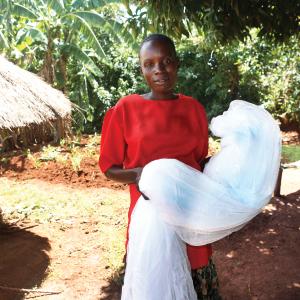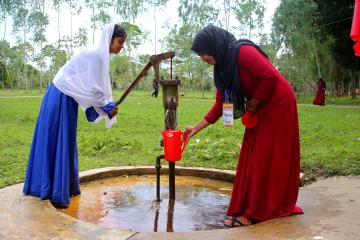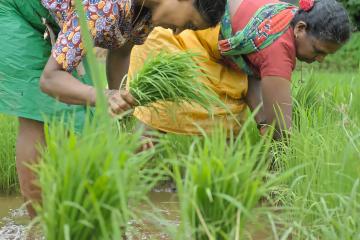
Many more people use preventive health products like mosquito nets, water-purifying chlorine tablets, and deworming pills when they are free.

Policymakers and implementers should scale up free distribution for preventive health products that all households need, and consider using free vouchers for those that only some households need. Because there are community-wide benefits when usage rates are high for these products, making them available for free amounts to not only greater impact, but also greater value for money.
Free preventive health products lead to better health and lower burdens on health systems. When health products are offered free of charge, more people use them, resulting in better health for more people.
Even people who need the health products most are highly deterred by small fees. Charging fees can make a program less cost-effective by excluding people who otherwise would have used and benefited from a product, while raising little revenue.
Each year, preventable diseases like malaria and dengue cause the deaths of 700,000 people. Intestinal worm infections affect an estimated 1.5 billion people, mostly in poor communities. Left alone, these diseases also take a massive economic toll, costing low- and middle-income countries billions of dollars each year through healthcare costs, lost productivity, and missed opportunities for education and economic growth. What do mosquito nets, deworming pills, and water treatment products have in common? They are examples of cheap, proven tools that protect people from these common preventable diseases, especially in low- and middle-income countries.
When people use these preventive products, they’re less likely to get sick from preventable illnesses. That means kids miss less school, adults miss less work, and families are healthier. But the impact doesn’t stop there. Because many illnesses are contagious, if these products are widely used in a community, it can stop disease outbreaks before they start, keeping others in the community healthy too.
Some might assume that charging a fee for these products ensures they reach people who value and plan to use them—or that paying a fee makes people want to use the products more. But research tells a different story. Evidence from seventeen studies shows that even low prices can discourage families in need from accessing them, actually reducing the reach and effectiveness of these products. Several studies also show that design tweaks, like offering free vouchers, can lower cost without reducing impact by making sure families who are motivated to use a product can access it.
The policy takeaway is clear: Policymakers and healthcare providers should eliminate user fees and distribute cheap but effective preventive health products for free. Offering them for free makes it far more likely that people actually get and use them, benefiting themselves and others.


Charging fees for many preventive health products dramatically reduces take-up. Preventive health products distributed for free are generally put to good use.
Cost and design considerations
Charging fees doesn’t help a program become financially sustainable. Across eight countries and several different types of products ranging from bednets to vitamins, when the price of preventive health tools went up even a little, far fewer people obtained them. This steep drop in take-up—including among people most in need of the product—means charging fees can reduce reach and cost-effectiveness. To make free distribution work, public health organizations need support from philanthropy, bilateral aid, or governments.
Even modest, subsidized fees reduce adoption. That means fees raise very little revenue. For example, take-up of insecticide-treated bednets among pregnant women at antenatal care clinics in Kenya dropped by 60 percentage points (from 99 percent to 39 percent) when the price increased from zero to US$0.60—an amount that still represented a 92 percent subsidy of the US$7 market price.
While it may seem counterintuitive, free distribution reaches enough additional people that the overall program budget is more cost-effective. In Kenya, for example, dramatically fewer families took deworming pills for their children when fees were charged, resulting in much higher net costs per child treated. Researchers estimated that while charging a small fee may have been slightly lower cost per child life saved, free distribution saved far more lives overall, leading to greater cost-effectiveness.
For some products, keeping them free but adding small steps like asking families to redeem vouchers to receive the product can make distribution more cost-effective. This is because vouchers act as an effective self-screening tool: Families who are motivated to use the products are the ones who take the time to redeem them. In Kenya and Malawi, for example, vouchers for water treatment solutions helped reduce waste while still ensuring high usage, leading to stronger public health impacts.
While it may seem counterintuitive, free distribution reaches enough additional people that the overall program budget is more cost-effective.
Implementing partners
Implementers bring deep local knowledge, technical expertise, and a commitment to evaluation and learning as they bring these programs to life. Organizations that, to the best of our knowledge, integrate these lessons into their programming include the following (listed in alphabetical order); this list is not exhaustive.
- Against Malaria Foundation (worldwide)
- Evidence Action (worldwide)
- Investing in Children and their Societies (ICS SP) (Africa)
- Malaria Consortium (worldwide)
- Partners In Health (worldwide)
- Population Services International (worldwide)
- TAMTAM (Africa)
- The Global Fund (worldwide)
Today, many organizations support free distribution as an effective way to improve health. Free access to deworming has scaled to reach over 350 million children across India, Kenya, Nigeria, Malawi, and Pakistan as of 2023 and nearly 200 million insecticide-treated bednets have been distributed as of 2024.

Discover more from J-PAL
Discover more from other sources
Africa: How can we achieve a malaria-free world?
AllAfrica
Insecticide-treated nets for preventing malaria
Cochrane Collaboration
Mass distribution of insecticide-treated nets (ITNs)
GiveWell
Small changes, big results
Boston Review
WHO publishes recommendations on two new types of insecticide-treated nets
World Health Organization (WHO)
Photos:
(1) Women in northern Ghana pumping water from a well, which is their village’s only source of clean water. Credit: Rekindle Photo and Video, Shutterstock.com
(2) A woman in rural Kenya holding a mosquito net. Credit: Aude Guerrucci, J-PAL/IPA
(3) Two pharmacy employees. Credit: Dan Bjorkegren, J-PAL/IPA

